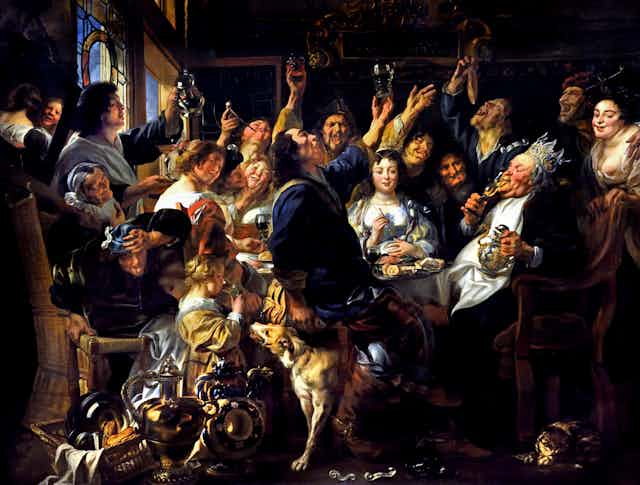The festive season in medieval Christendom included many traditions that are not echoed in the current celebrations, and a few that are. Here are seven which capture and evoke the spirit of Christmas and New Year long past. These cover the 6th century to the 16th, and focus on Christian Europe. Festivities extended from December 1 to at least January 6 and for some as late as Candlemas, a Christian feast day on February 2 commemorating the presentation of the baby Jesus at the temple in Jerusalem.
Serve up the boar
Christmas and New Year coincided with the hunting season for wild boar, at least in medieval England where it ran, similar to today’s hunting season, from September 8 to February 4.

References to boars’ heads at feasts of the period are common. A recipe from the 1420s associated with the master chef of Savoy, Chiquart, gives detailed instructions for decorating the heads in bright colours. They were then paraded breathing flame (courtesy of a candle, camphor, and spirits) as part of the dinner spectacle.
A famous procession of the boar’s head around Christmas time was associated with Queen’s College, Oxford, from the 14th century. This honoured a student who had unexpectedly encountered a boar in the woods and, with great presence of mind, dispatched it with a copy of the works of Aristotle he was carrying. The boar’s head also inspired it’s own medieval carol:
The boar’s head in hand bring I,
Bedeck’d with bays and rosemary.
And I pray you, my masters, be merry
Quot estis in convivio (as many of you as are gathered together)
A Christmas feast of codlings and eels
References to the word Christmas only begin in the 11th century to indicate the first service of the day as Christ’s mass. The four weeks of Advent were established by Pope Gregory the Great in the 6th century. These were designated as a period of fast, so in dietary terms fish predominated.
In 1289, the Bishop of Hereford served a Christmas Eve meal to his guests of herring, five conger eels, 30 codlings and an expensive salmon, bread and wine. Christmas itself was given the status of a feast, and this was extended up to the Feast of the Epiphany, the visit of the three kings, on January 6. This made the twelve days of Christmas a period of holiday for all medieval Christians, and one where meat could be eaten.
Deck the halls
Christmas trees are a post-medieval innovation – which became popular in some European countries in the 17th century, via the German wife of George III, but didn’t really catch on in Britain until the 19th when it was made popular by Queen Victoria and her German husband Prince Albert.
Medieval Christmas was not, however, without festive greenery: bay leaves, rosemary, holly, ivy and mistletoe were all used as decoration. This is similar to the Roman celebration of Saturnalia (December 17-23) over which the Christian Christmas festive season lay.
The nativity play
Strange as it may sound the idea of reenacting the nativity scene had to wait until the third decade of the 13th century. It seems to have been the brainchild of St Francis of Assisi, founder of the Franciscans. Francis was famous for his sermons not only to people but to also to animals.
In 1223 Francis happened to be in the town of Greccio, Italy, for Christmas, and asked for permission from the pope, in case he was thought to be making light of the Christmas story, to set up a manger full of hay, to bring an ox and a donkey, and to hold a service in front of it that evening. He preached to the townspeople who had gathered around, and a soldier among them became convinced he could see the holy infant sleeping in the manger. And the nativity tableau was born.
Read more: How St. Francis created the Nativity scene, with a miraculous event in 1223
Bean kings and boy bishops
Medieval Christmas could be a world turned upside down. One example, in vogue at the English and French royal courts in the 14th century was choosing a Bean King. This individual, who selected a slice of cake with a bean in it, was then elected “king” for the proceedings. By the later Middle Ages the more raucous tradition of the boy bishops was well established, where a boy was elected in a parody of an adult bishop, leading proceedings, but also incorporating pranks.

Sometimes elected on December 6 – more often on January 1 – the bean kings merged with the Feast of Fools, when a mock pope was elected.
Roland the Farter
A real person, probably a jester at the court of Henry II of England (who reigned from 1154 to 1189), Roland’s festive duties consisted of making a jump, a whistle, and a fart (bumbulum in Latin) before the king. He must have impressed his audience and patron since he was rewarded with an estate of some 12 hectares in Suffolk.
While some of the medieval traditions have faded away, in the 21st century many modern Christmases still retain a bit of misrule, a fart joke and plenty of cake.

